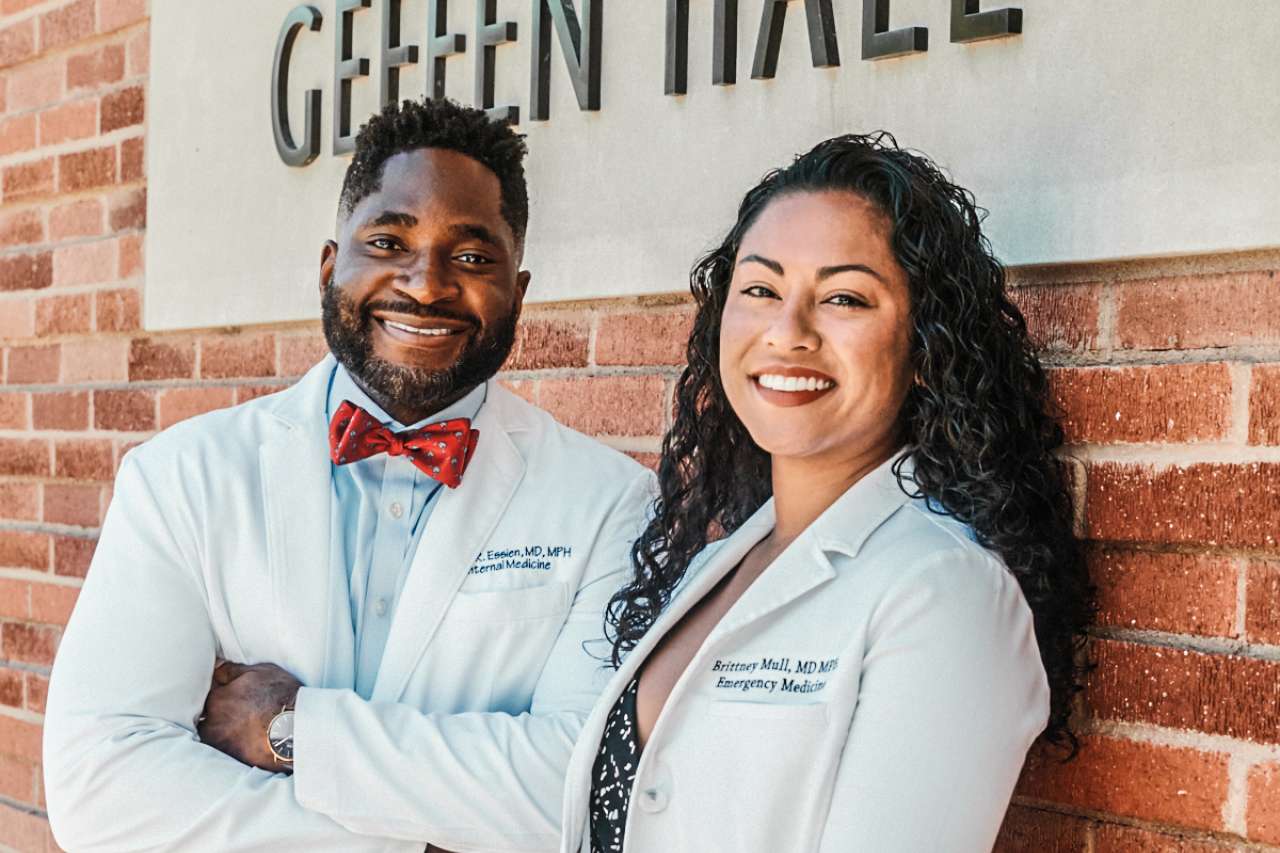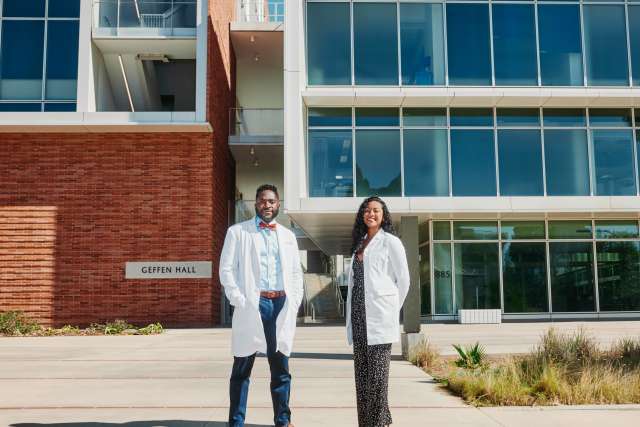Two UCLA Health researchers take a hard look at the obstacles that hinder many aspiring students from underrepresented racial and ethnic groups from applying to medical school.
Jessica P. Faiz, MD, MSHPM
Assistant Clinical Professor of Emergency Medicine
Core Investigator, VA Center for the Study of Healthcare, Innovation, Implementation and Policy
Utibe R. Essien, MD, MPH
Assistant Professor of Medicine
Health Disparities Researcher, VA Center for the Study of Healthcare, Innovation, Implementation and Policy
Associate Vice Chair, Equity, Diversity and Inclusion, UCLA Health Department of Medicine
When Jessica P. Faiz, MD, MSHPM, and Utibe R. Essien, MD, MPH, were students at the Albert Einstein College of Medicine in the Bronx, New York, and trainees in Boston, they saw first-hand the negative impact of health care inequities on patients from underrepresented and underresourced groups. “As a resident in emergency medicine at Boston Medical Center, which is a county facility, I treated a very diverse patient population and saw the real effects of structural racism on patient outcomes,” Dr. Faiz says. “While I loved being at the bedside, I knew that there was much change that needed to happen.”

Today, Dr. Faiz is assistant clinical professor of emergency medicine in the David Geffen School of Medicine at UCLA and a health-services researcher at the VA Greater Los Angeles Healthcare System. Dr. Essien is assistant professor of medicine in the David Geffen School of Medicine and a health-disparities researcher at the VA Center for the Study of Healthcare Innovation, Implementation and Policy.
This past spring, Drs. Faiz and Essien — in collaboration with Donna L. Washington, MD, MPH, professor of medicine, and Dan P. Ly, MD, MPP, assistant professor of medicine and health-services research — published a study in which they found that Black, Hispanic and Native American students taking the Medical College Admission Test (MCAT) prior to applying to medical school have more financial and educational barriers and face greater discouragement from important advisors compared with their white counterparts. Even though they sat for the test, such obstacles often dissuaded the students from applying to or attending medical school, the researchers concluded.

In addition to diminishing diversity within medical schools, the downstream impact for patients can be profound. “Having a doctor who looks like them makes a patient more likely to accept flu vaccination, to have a colonoscopy, to consider having a more invasive heart procedure,” Dr. Essien says. “We’re not just advocating diversity out of the goodness of our hearts. It literally is about saving lives.”
Drs. Faiz and Essien talked about their study with Natalie J. Perry, PhD, lead for the Cultural North Star Program in the David Geffen School of Medicine at UCLA. Their conversation has been edited for length and clarity.
I am so excited to talk to you today. This is such an important discussion. Why are you engaging with this topic now?
Dr. Faiz: Working as an emergency medicine physician and being on the frontline of care delivery, I’ve seen the horrendous effects that systemic racism can have on patients and how it can threaten their lives. But I’ve also seen how excited patients are, and how comfortable they become, when they see a physician who looks like them and who speaks their language. That has made me passionate about looking into the question of why our physician workforce is not as diverse as it should be. That led to our research question and looking at upstream barriers for medical students.
Dr. Essien: For me, it’s personal. I am a Black man in medicine. We are 3% of the physician workforce in this country, and that number hasn’t really changed since my dad graduated medical school in Nigeria over 40 years ago. So, the work of trying to improve those numbers is super personal and very important to me, both for our patients and for the communities that we grew up in. There have been people talking around the edges of this issue for years, and there are those who want to pretend that it’s not about race when, in reality, it is. All we have to do is look at the statistics: 3% Black male physicians, 5.7% Black physicians in general, 7% Hispanic physicians, 1.2% Native American physicians. Compare that to the national averages of 13.6% for the Black population in the United States as a whole, 18.9% for the Hispanic population and 2.9% percent for the Native American population. The underrepresentation is clear.
Dr. Faiz: There are countless accounts, going back generations, of Black, Latino and Native American people being mistreated in medicine and dying disproportionately, and I think, ultimately, diversifying the physician population is not just about increasing numbers in the workforce; it is literally about improving patient outcomes and saving lives. A recent study showed that for every 10% increase in the number of Black primary care physicians in a county, there was a 31-day higher life expectancy for Black individuals living there.
Dr. Essien: Having Black and brown physicians is integral to questioning the status quo in medicine. These doctors are more likely to spend time listening to minoritized patients, provide guideline-recommended care and understand the health impacts of the racist history of medicine.
By the time someone sits down to take the MCATs, they’ve demonstrated a determination to become a doctor. What, then, are the barriers to entry into medical school for students from underrepresented and underresourced racial and ethnic communities?
Dr. Faiz: This is what we sought to answer through our study. We looked at a cohort of more than 81,000 students who have gotten to the point where they’re taking this very rigorous exam, are very committed, but still experience upstream barriers. That includes things like having attended low-resourced colleges, having parents without a college degree, difficulty affording MCAT-preparation materials and having more pre-medical school debt. These are barriers that decreased their likelihood of applying to and attending medical school.
Dr. Essien: There often is a lot at play in the lives of these students. It’s not that they didn’t know how to take a test or that they didn’t study hard enough during their undergraduate education. It can also be that they were in a family where they had to take a job as an undergraduate to help provide for their family, as well as support themselves and earn money to pay for their tuition. And there also is the issue of mentoring, which is significant. A striking finding in our study was that what we refer to as “underrepresented in medicine examinees” were more likely to report that they had a college pre-health advisor who negatively influenced their journey toward medicine. Taking all these factors together — and having nothing to do with their MCAT scores or their letters of recommendation or their volunteering experiences — we saw that nearly one-in-five Black and Hispanic individuals who experienced these negative upstream effects didn’t go on to apply to or attend medical school.
Dr. Faiz: Given the results of our study, there are undoubtedly students from underrepresented backgrounds who are interested in medicine but who are being deterred even before they take the test. If we see that these barriers exist for those who are already taking the MCAT, we can only imagine how many students are falling off before that. And we know that that has to be due to systemic factors.
What do you think needs to be done to address this issue?
Dr. Faiz: I think that to move the needle, education and support needs to happen at every single level in a student’s journey. It has to start with the people who are advising and guiding students at the high school and undergraduate levels along the entire pathway toward applying for medical school. This extends, also, to supporting and retaining students once they have gotten into medical school. There needs to be a baseline understanding of how structural barriers have affected them up until this point. We hope that our paper will prompt people who are in advisory positions to recognize the structural barriers that are in place and take the circumstances of students’ lives more into account, and to think creatively about how to dismantle existing barriers and not just count a student out if they do poorly in a class or behave in a certain way.
Dr. Essien: Taking a holistic perspective of students who are in these pipeline and pathway programs, and understanding the circumstances of their lives, is critical. As is taking measures to eliminate economic barriers at every step of the pathway to medicine. The Association of American Medical Colleges has proposed solutions that include broadening the benefits for their medical school Fee Assistance Program, removing costly medical school application fees — which can cost up to $150 per school — and continuing virtual interview options to limit travel expenses.
Dr. Essien, you spoke of the negative impact that an advisor can have on the direction of a student’s trajectory. Positive mentorship is so important.
Dr. Faiz: It is. As an early-career faculty member, I can’t get enough mentorship. And I think that, particularly for young physicians from underrepresented racial and ethnic groups, it is important for retention for them to have that kind of support and to create an environment in which everyone can thrive. I don’t think it is ever too early to start mentorship. It can begin in kindergarten to expose young people to what is possible in science and medicine.
Dr. Essien: I was fortunate that my dad was a doctor, and though I spent a lot of years not wanting to go into this field, I ultimately was able to see what this world looked like, and I really was inspired by it. Not everyone will have that kind of opportunity, which is why we need to create spaces for that kind of exposure to happen.
What will be the next step for this research?
Dr. Essien: One question we have is around the intersection of race and sex or race and gender. Appreciating and acknowledging that intersection is really important, and the fact that there are different levels of mentorship and support that a Black man might receive, for example, versus what a Hispanic woman might receive.
You’ve touched on many barriers to entry for students from underrepresented racial and ethnic groups and discussed the need to dismantle these barriers at a societal or institutional level. What can individuals do at the more grassroots level to help? What is your prescription for change?
Dr. Essien: At a grassroots level, everyone who is engaged with this question at some point along the path of a student’s journey can familiarize themselves with the data we’ve shared and, hopefully, come to understand why diversity in medicine isn’t just the right thing to do, it actually is necessary to save lives. For those of us who are involved in the admissions process in any way, it is important to undergo antiracism training to ensure that we are not bringing our own biases into the evaluation process. And, finally, we can continue to use our voices to advocate for the reversal of policies, such as legacy admissions, that systematically disadvantage students of color.
“Racial and Ethnic Differences in Barriers Faced by Medical College Admission Test Examinees and Their Association with Medical School Application and Matriculation,” JAMA Health Forum, April 14, 2023

